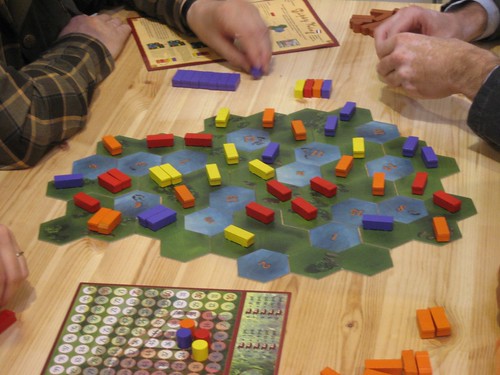
Gipsy Kings by Cwali. Bits are wooden caravans. Board is modular. Disembodied hands not included.
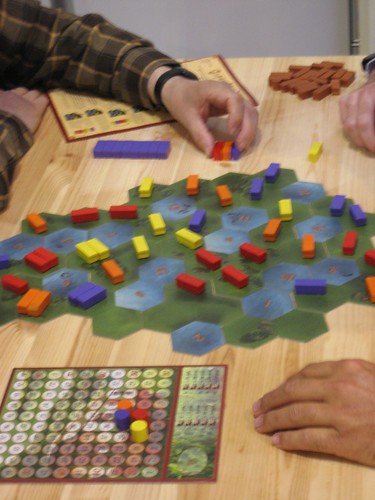
Blue bits are the ponds. Scoreboard in foreground.

3D Stratego, I kid you not.
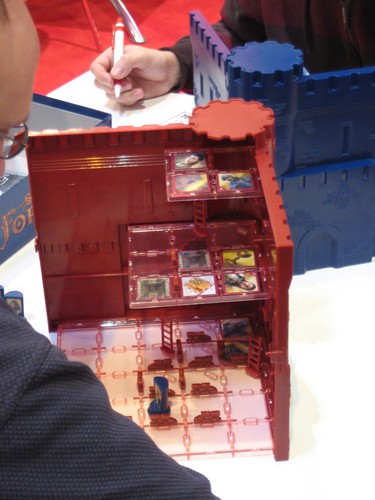
Stratego Fortress (B)
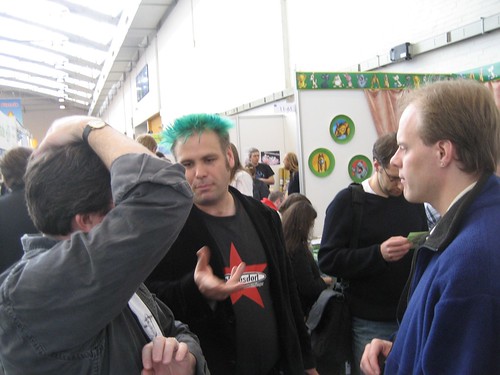
Friedemann Friese, with Charlie Reiman and a person avoiding being seen

I want that one! (2F-Spiele booth)
Check out the cute Felix the Cat plates on the wall.
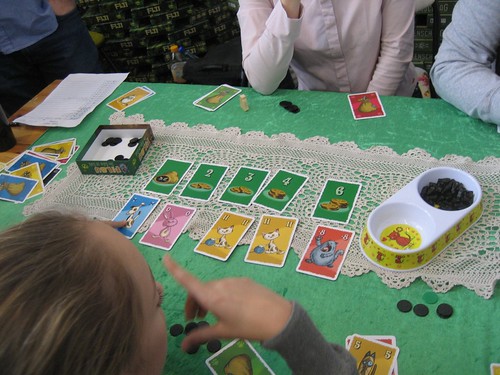
Filou: "Cat in a Sack" means "Pig in a Poke" auf deutsch.
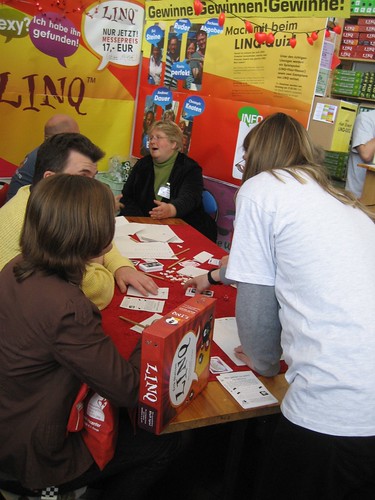
Linq. Andrea Meyer in background. Heli Barthen
in foreground?
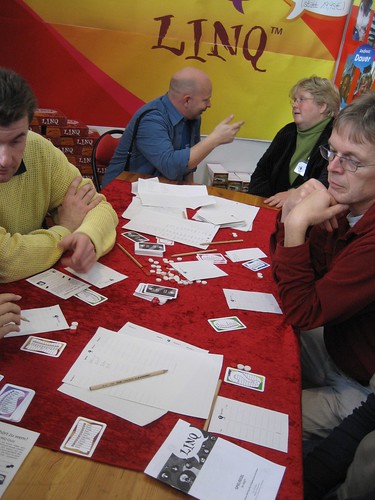
Socializing game about matching up attributes of the players
themselves, I believe. Too much German for non-German speakers,
says Andrea.
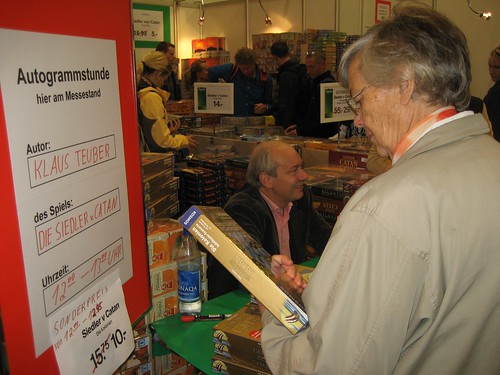
Background, the legend: Herr Klaus Teuber. The 10 year edition of Seafarers has triremes! I am not a fan of that expansion, but triremes! Lord help me!
I had him sign the Settlers dice game. Ouch. Hey, if he's gonna license out his name, he's gonna have to own it afterwards!
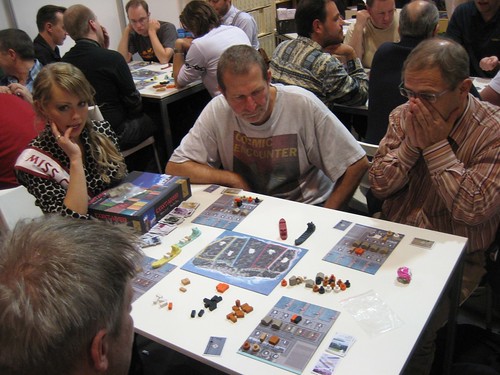
Miss CANADA! Oh yeah, and Container by Valley Games

More Container
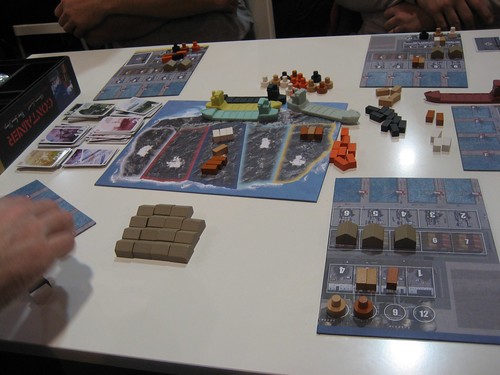
We miss you, Benno.
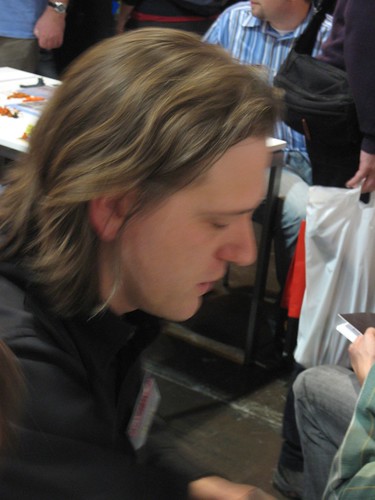
Benno's co-inventor, Thomas Ewert.
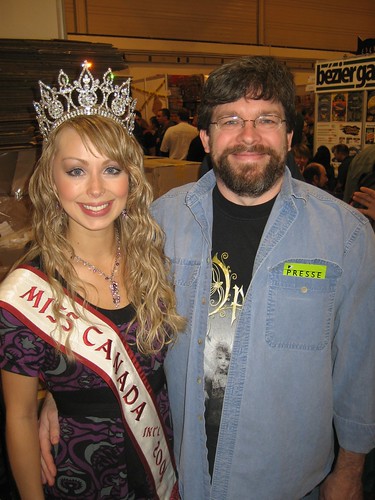
The grin says it all.
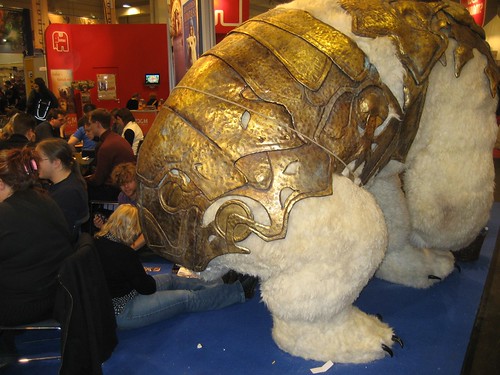
She survived ...

... we may not.
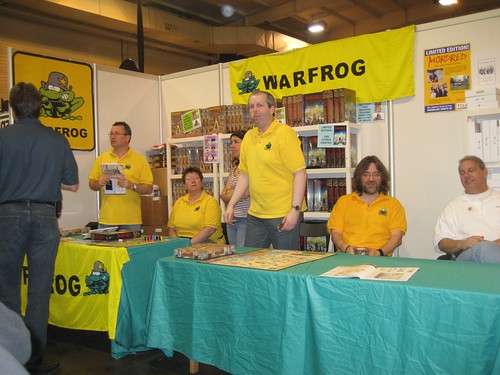
Warfroggies! (Martin in back left?)

Nexus motorcycle race prototype

More

You can almost hear the engines.
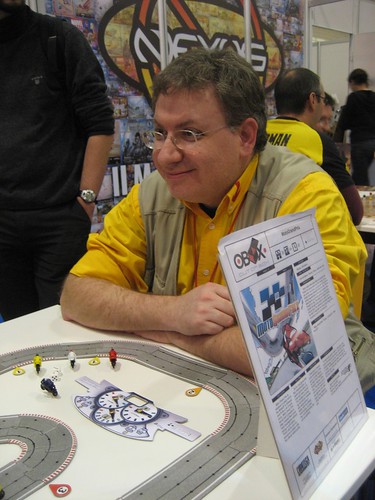
Inventor ...
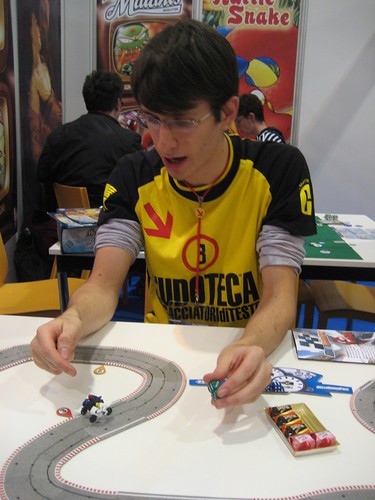
... and assistant
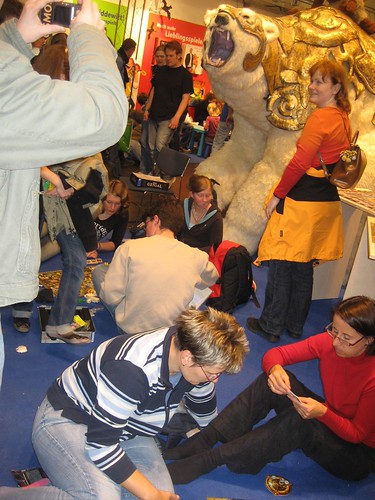
Not Insane But Still Very Busy
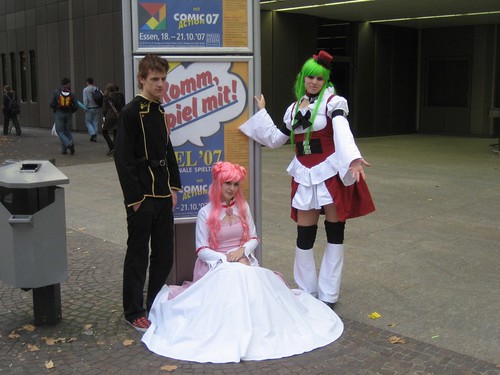
"Komm, spiel mit!" – "Come play with us!"
Best of show so far is split between two queens: Container from Valley Games (demoed by the queen of Canada) and Andreas Seyfarth's Giganten der Lüfte by Queen.
Container was introduced by Miss Canada at the booth. This beauty queen has some solid gaming chops. You can tell that from the look on Kurt's face! The game was very good as well.
Container (review) is an economic sim that covers the supply chain beat. Players manufacture goods in one of, I believe, five types. Each player is dealt a card ranking the five types from scoring 10 per unit down to 2. In order to score, the goods need to be moved from manufacturing to distribution to shipping and finally sold at the retail end of the chain. Players start with one factory that manufactures one particular type of good and can buy more with each successive factory costing more. By paying the player on their right one dollar, they can run their factories, producing one good per factory, and then price those goods. Players can then buy from each other's factories and move the units to their warehouses on the docks where they are, once again, priced. The warehoused goods can be loaded onto other player's container boats, for a price. The boats then, eventually, sail to the land o' consumers where the goods are auctioned off. The bank doubles the bid and the buyer stores the goods for later scoring. Game ends when two goods have all been manufactured (the pool is exhausted in two colors). Players then discard the type of good they have collected the most of in their bulging bungalow in the land o' retail. The remainder are scored along with cash in hand and small points for goods on ship or in warehouse.
Play is quick with lots of interaction via pricing and buying. And it all wraps up in one hour. In our game, the winner held a lot of cash from a lucky auction, second held lots of goods in his bungalow, and the other two were split between goods and cash. Good fun. Thumbs up all around.
Our young guide mentioned that others had been vexed when they managed to spend all their cash without making any money. No surprise: they had few options to move forward. The game does offer loans at 10% per turn for just such an unhappy catastrophe, but our guide pointed out that the whole point of the game was to consider how you would make money as you went along. This reporter agrees.
Giganten der Lüfte (B) is a game about zeppelin building. It is a dice game using three colors of six sided dice. Each player starts out with two white dice and a small number of target tiles to collect. Each tile specifies how many dice of each color must be thrown and the total that must be achieved to collect that tile. Tiles are one of six types and players may only keep one of each type at a time. Some nice decisions around when to upgrade and how to value different tiles given the ones you already have. Eventually players begin collecting zeppelin tiles and may even begin construction on the Hindenburg. Zeppelin tiles and some others are marked with a number of victory points. When enough construction has been completed, the game ends. Good family fun. One wag from Mattel claimed that he had been trying to publish this for years and was glad to see it finally hit the streets.
Gipsy Kings (review) from Cwali is a nice, light tile laying game. A random modular board is constructed featuring a number of ponds, some with fish. Each pond is numbered and players take it in turn filling the space around each pond in pond number order. Players may elect to pass, which leaves them at the top of the turn order. When they do, other players have the option of placing. If they do, they move to the back of the turn order and the passing player once again has the option of moving. If all players pass, the last must place. This passing mechanism gets used more than you might think. The goal is to dominate each pond edge and majority scores points equal to the most fish in a single spot in the pond with second snagging second most, etc. Players also score for large, adjacent sets of pieces with one scoring one, two scoring three, three scoring six,... (name that sequence!). Once the board is full, score then repeat with pond order reversed. Score again and you are done. Sweet, light, abstract: very Corné!
Hamburgum (review) is the rondel descendant of Antike and Imperial. This time we are looking at economics. Players collect and sell beer, sugar and cloth. They invest in real estate to increase their income. Then they build large churches to celebrate their good fortune. Everything scores victory points in as many ways as you could think of. This one drives along the ragged edge that League of Six (review) blithely tumbled off of with a mighty Yah-hah-hoooeeeey! but manages to just keep from tumbling over. Some hard decisions about what to do when, a real feeling of racing with the other players, and a sane number of choices with clear values that change nicely over time make this one a winner. And it's much faster than Imperial. Woot!
Crazy Diamond (B) is a parallel solitaire racing game about smuggling diamonds through South America. Lead player rolls a die and all other players move diamonds down their maps from top to bottom. Die is marked 1 to 4 plus anchor and airplane. Anchors allow players to ship from one port through another and on to a stop at the second port along the central rivers; airplanes allow moves from airport to airport. Once diamonds begin to exit the country, players can use them to buy a driver's license (to drive on the freeway, of course) or to bribe town police to block other players. Each town may only be bought by one player. The other players can then pay the buyer off to regain access to the town. Once all the towns are sold and players pay off to open a reasonable route, the game settles into a fairly mechanical race to ship 25 diamonds before anyone else does. The game is definitely a diamond in the rough, as up until that last, fairly boring bit, it was great fun! Even with the non-interactive race time at the end, I would recommend folks check this one out.
Agricola (review) was a mixed bag. I did have fun, but really zero interaction – a strictly solitaire game. It presents an interesting and complex puzzle to solve, though, and that was fun – with the English cards. Without it would be a big hairball mess.
Three things to note:
1) parallel solitaire
2) the constant feeling that you have done something wrong –
we all had it.
I scored 2x the nearest contender and still had it. Built into the design.
3) No way to read who is current winner but nothing to be done about it
anyway ...
And with all that Kurt and I still agonized over whether or not to buy – then didn't.
Other games of note:
Make You Gunfighters (review) – light Japanese filler card game with anime figures shooting up a Western town. Rules quote: "Remember, it's fun to shoot at your friends!"
A motorcycle racing prototype due out next year from Nexus. Racing mechanism is a simplification of the Das Motorsportspiel's (review) dice flipping. Flipping restrictions apply in turns, limiting players to slowing down. Passing in turns reduces movement distance depending on tightness of corner. Wheelies, bumping, and other goodies also showed up. Might be good, but modular track makes this one a must have to racing fans.
This Essen has been plagued with production problems:
- The Mr. Jack expansion (review) finally arrived on Saturday.
- Bambus only had 50 or so of their new game, Down Under (review), but will have several hundred more available after the fair.
- The Mosquito expansion (B) for Hive that was, no doubt, meant to promote the game at Essen is now delayed till December, at best.
- Heartland (B) from Pegasus was a no-show, as well.
- Most probably already know about Monastery ... (B)
Crowds have been very light owing to the rail strike here in Germany and, starting today, cold weather. Saturday showed a solid uptick in attendance, but was not the elbow to elbow disaster of years past. Still good for us, but I worry about the vendors with boxes of unsold games piled high ...
– Ken Tidwell, October 19, 2007
The previous report is here.
Comments to spotlightongames.com